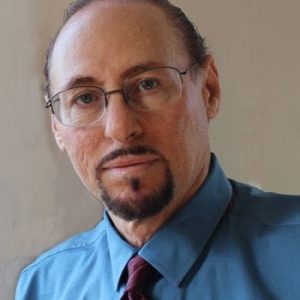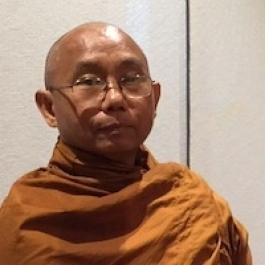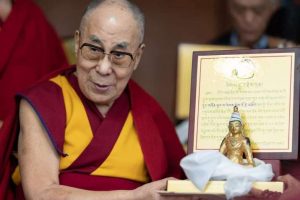
The moment I walked out of the three-year, three-month meditation retreat in 1989, my world was turned on its proverbial head. I had expected the basic structure of reality would always be the same. Only the content would change. New fashion, new music, new movies, new technology. People would be as before, only with different ideas and attitudes. But no, the actual container, the structure and configuration of the world had changed—not just the content. And the shape of mind itself had changed, the everyday mind in any case. I understood then that fitting the square peg of the 11th century spiritual methods that I had been studying into the round hole of the 21st century was a fool’s errand. A different peg was needed. The essence of these profound truths would always be the same, must be the same. But that peg had to mirror the form and structure that fits the reality of right now: the challenges, the chaos, the opportunities, and the reformatted shape of everyday mind.
This kind of spiritual renewal is needed in every generation. Making methods of healing and transformation accessible and effective has been the work of great adepts throughout the ages. Be it in a tribal village or grand civilization, those who are a product of their time and culture are the best vehicle to express timeless wisdom in a form contemporary to their world. Such a person is generally recognized by their peers in the spiritual hierarchy, as well as the majority of the people, for their various qualities and development. This status may have been won through great effort or conferred through lineage or bloodline. In Tibetan Buddhism this renewal became fully formalized in several unique ways. The tulku system depends on the intentional reincarnation of a realized being, either as a blood relative or any regular folk. Either the adept leaves a letter indicating where the next emanation will be, or a child showing unique qualities and cognition of their past life may be discovered. But there is a rub.
While the Buddhism of Tibet and Bhutan summons up images of wild yogis and yoginis dwelling in mountain solitude and wandering in verdant valleys, such beings were and are in the minority. Tibetan, and all other forms of Buddhism, are highly hierarchical. Thus in the real world, transmissions of spiritual power are subject to favoritism, nepotism, politics, monetary concerns, status, and many other forms of corruption. In that case, renewal becomes unlikely. A more direct and more rarefied tradition is that of the terton, those who have the special ability to discover hidden spiritual treasures, which appear in the earth, under water, in the sky, or simply in the open sky of mind. The story of the origin and unlocking of these cryptic messages has of course been well described elsewhere. But their purpose is to refresh the perennial wisdom of Vajrayana or tantric methods with innovative practices. Such terma treasures are very respected and well received.
On the other, far end of the scale, are the free-flying inventions of the modern ego turning its voracious gaze toward spirituality. In some places, such as Sedona, Glastonbury, and Ubud in Bali, throwing a stone in any direction will hit a dozen or so gurus with self-revealed teachings and techniques. But one older example is enough to express the gist. Starting in 1902, C. W. Leadbeater wrote a series of books describing the chakras and aura (subtle body) in great detail: how the chakras and aura appear in the body, what disturbance or ill health look like, and how “thought forms” appear as they they pass from one person to another. This was all based on his clairvoyant experience. Almost anyone who is immersed in spiritual practice, bio-field healing, energy medicine, yoga, tai-chi, or meditation in its many forms is aware that there is a vast spectrum of possibilities for human development and nuances of consciousness. Psychic development, deeper sensitivities, and empathic skills are a reality, no matter what Wikipedia may state. But the water becomes murky indeed with the “anything-goes” and “make-up-whatever-reality-you-choose” paradigm of New Age thinking stretches to its outer limits. Leadbeater’s personal experiences have been cloned and copied endlessly, while having no corroboration in any original traditions or practice. I mean, funnel-shaped chakras? Spleen chakra?

So where does this leave the Buddhist, Christian, Daoist, or Hindu contemplative practitioner? Even more so, what about the teachers of these spiritual pathways? Are they tied to a rigid set of dogma and methodology, and a restricted mode of thinking and feeling? Or are they free to adopt the “I am my own religion” mindset, or to invent the next great thing out of their personality, rather than their essence? These are tough questions, and ones that have not been adequately examined, with examples of both the hide-bound and free-wheeling ends of the spectrum found in great abundance. But as is often the case, we find that both polarities express important truths and there is a kind of “middle way.”
Tradition is the vehicle, the enclosure that allows us to practice in an accurate, relatively safe, and tried-and-true context. But there are points at which long personal experience starts to amplify or stretch the boundaries of this narrative. No one’s visualization is the same, nor their pronouncement of a mantra. And their experience is also unique in many subtle ways. For any spiritual practice to be a lived experience, when one touches Wisdom Mind, then the real guru, deity, dakini, and so on show up, and can be quite different than a painted thangka or statue. We can only dwell in theory, or, as I like to stay, “stay in short pants” for so long. The tradition is there to liberate you, not lock you forever in a Dharma prison. But again, when is it real freedom or just the same old mundane, self-centered ego trip? The answer is surprisingly simple and thus usually missed.
One way to arrive at this point is to research and practice for a long time—and then to let go. Allowing genuine experience, sincere intention, and silence to cook in the crucible of the soul, until “something” new can arise. During my three-year retreat, I had fallen painfully into an essential core, a naked and raw way of being that is free from all the programming and entrainment that fills our lives. That is a touchstone from which Wisdom Mind can speak, however you get there. And anything that does not resonate with that is always suspect, is just neutral, more trees and rocks within the landscape. This solid foundation, this thing you can trust, has been given a variety of names in passing, but has almost never become what it should be—a part of our daily jargon and spiritual language. I always loved the Tibetan phrase “injie minjie go gi doo!” which means “absolutely necessary!” Maybe the term that fits best is “essence,” one used by the great modern day adept, G. I. Gurdjieff.
If one cannot yet differentiate essence and the programming of persona within oneself, then all dogma should be adhered to. And if essence is present, wisdom can speak, and its voice will overpower any false narratives. Then Dharma will still be the Dharma, but not the Dharma you started with, nor necessarily how it sounds in a book. It is the splash of freezing cold water that Chogyam Trungpa spoke about, disturbing our tepid bath. Vajrayana is a dangerous game and, as the wonderful late and great Dawa Rinpoche said: “Cutting through is not for the faint-hearted.”
See more
Related features from BDG
Confronting the Five Horsemen of the Current Apocalypse
Book Review: The Tibetan Yogas of Dream and Sleep
Awareness, the Beginning of Change















It’s intriguing how tradition and innovation often clash within spiritual practices. The balance between preserving sacred customs and embracing new ideas is a delicate one. This article beautifully explores the challenges and opportunities that arise from this dynamic. How can we ensure that the core essence of our traditions remains intact while allowing for necessary growth and adaptation in today’s ever-changing world?